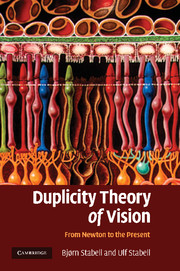Book contents
- Frontmatter
- Contents
- Acknowledgements
- 1 Introduction
- Part I The development of the basic ideas of the duplicity theory from Newton to G. E. Müller
- Part II The development of the duplicity theory from 1930–1966
- Part III Chromatic rod vision: a historical account
- Part IV Theories of sensitivity regulation of the rod and cone systems: a historical account
- 15 Introduction
- 16 Early photochemical explanations
- 17 Contribution of S. Hecht
- 18 Contribution of G. Wald: photochemical sensitivity regulation mechanisms of rods and cones
- 19 Relationship between amount of rhodopsin and sensitivity during dark adaptation
- 20 Post-receptor sensitivity regulation mechanisms
- 21 Rushton's AGC model
- 22 Contribution of H.B. Barlow
- 23 Rushton and Barlow compared
- 24 The Dowling-Rushton equation refuted
- 25 Several mechanisms involved in sensitivity regulation
- 26 Sensitivity regulation due to rod-cone interaction
- 27 Modern conceptions of sensitivity regulation
- Part V Factors that triggered the paradigm shifts in the development of the duplicity theory
- References
- Index
26 - Sensitivity regulation due to rod-cone interaction
Published online by Cambridge University Press: 22 January 2010
- Frontmatter
- Contents
- Acknowledgements
- 1 Introduction
- Part I The development of the basic ideas of the duplicity theory from Newton to G. E. Müller
- Part II The development of the duplicity theory from 1930–1966
- Part III Chromatic rod vision: a historical account
- Part IV Theories of sensitivity regulation of the rod and cone systems: a historical account
- 15 Introduction
- 16 Early photochemical explanations
- 17 Contribution of S. Hecht
- 18 Contribution of G. Wald: photochemical sensitivity regulation mechanisms of rods and cones
- 19 Relationship between amount of rhodopsin and sensitivity during dark adaptation
- 20 Post-receptor sensitivity regulation mechanisms
- 21 Rushton's AGC model
- 22 Contribution of H.B. Barlow
- 23 Rushton and Barlow compared
- 24 The Dowling-Rushton equation refuted
- 25 Several mechanisms involved in sensitivity regulation
- 26 Sensitivity regulation due to rod-cone interaction
- 27 Modern conceptions of sensitivity regulation
- Part V Factors that triggered the paradigm shifts in the development of the duplicity theory
- References
- Index
Summary
Perhaps the most profound change in our conception of the sensitivity regulation mechanisms, however, came when it was realized that the rod and cone activities were not mutually independent, but that rod activity could influence cone sensitivity and vice versa. Anatomical, electrophysiological and psychophysical studies all contributed to this change in view.
Well-founded histological evidence in favour of the rod-cone interaction hypothesis was provided by Polyak's investigations of primates, summarized in Polyak (1941/1948). He discovered that, with the exception of the midget cone system, rods and cones were connected to the same pathways in the retina. Furthermore, he showed that the retina of primates was an extremely complex structure composed of a variety of different types of neural networks strongly indicating that the retina, and not just the brain, was involved in analyzing and synthesizing visual information.
More direct evidence in favour of rod-cone interaction was provided by Granit's ERG measurements. These results were interpreted to mean that rods and cones competed for ‘a final common path’ when excited simultaneously, and that the more active receptor types tended to exclude the other (see Granit, 1938, pp. 65–66).
Later on, Gouras and Link (1966) came to a similar conclusion. They investigated rod-cone interaction in Rhesus monkeys by analyzing the discharge pattern of ganglion cells connected to both rod and cone receptors. Their results showed that impulses from rods or cones arriving first at the ganglion cell would tend to block impulses from the other receptor type when these arrived shortly thereafter.
- Type
- Chapter
- Information
- Duplicity Theory of VisionFrom Newton to the Present, pp. 190 - 191Publisher: Cambridge University PressPrint publication year: 2009



